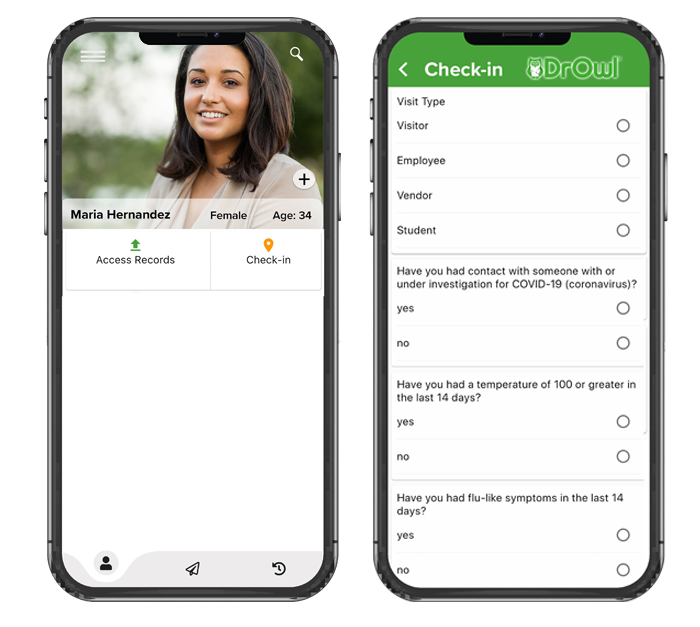“If you do become sick with a cough, fever, and shortness of breath, seek medical care. Use DrOwl’s telemedicine feature or call your doctor’s office to book an appointment. Only go to the emergency room if you experience difficulty breathing, pneumonia-like symptoms, or bronchitis-like symptoms. Avoid contact with others.” – CDC Recommended Guidelines, DrOwl blog.
The new coronavirus belongs to a family of viruses that can cause respiratory illnesses in humans ranging from the common cold to more severe diseases such as severe acute respiratory syndrome (SARS) and the Middle East respiratory syndrome (MERS).
Thought to have been transmitted to humans from an as-yet-unidentified animal source, the new virus spreads primarily through respiratory droplets, such as those generated when an infected person coughs or sneezes.
On average, it takes about five to six days for someone to show symptoms after becoming infected. However, some people who carry the virus remain asymptomatic, meaning they do not show any symptoms.
The virus multiplies in the respiratory tract and can cause a range of symptoms. You have mild cases, which look like the common cold, which have some respiratory symptoms, sore throat, runny nose, fever, all the way through pneumonia. And there can be varying levels of severity of pneumonia all the way through multi-organ failure and death.
However, in most cases, symptoms have remained mild. There has been some data on about 17,000 cases and, overall, 82 percent of those are mild, 15 percent of those are severe and 3 percent of those are classified as critical.
If you have a cough, a fever, or difficulty breathing, and you are worried that you may have COVID-19, the disease caused by the new coronavirus, here are recommendations on what to do, step by step.
1. Stay Home and Call a Health Care Provider
Unless it is an emergency, to reduce your risk of catching or spreading illness, stay home if you feel sick, even if your symptoms are mild. Do not go to work, school, or public places, and avoid public transportation. If your symptoms are severe or you feel like you need medical care, call before you go to your health care provider. Describe your symptoms over the phone. Or you could use an app like DrOwl to access a telemedicine appointment with a doctor.
DrOwl is a medical platform built on patented technology, that provides a safe place to sync your medical records. It was built to store, organize, search, and share your digital medical records on demand. DrOwl users can also share their customized Patient Portal with caregivers or family members to include them in the patient’s healthcare decisions. Users can initiate telehealth sessions and allow their caregivers or family members to join in the secure telemedicine video call.
However, if you have a medical emergency, call 911, and tell the dispatcher about your symptoms.
2. Answer Questions to Determine Your Risk
Use an app like DrOwl’s free screening and monitoring solution at facilities to help screen for symptoms or a history of exposure to COVID-19 which can help protect you. When you go to or call a health care facility, you will be asked about your risks for COVID-19. Risk factors include recent travel to certain countries or areas of the U.S., or exposure to an infected person.
For instance, people can be asked:
- Have you had close contact with someone diagnosed with COVID-19, the disease caused by the new coronavirus? (Close contact means having been within 6 feet of that person for an extended time or being exposed to their cough or sneeze.)
- Do you have a cough, fever or chills, shortness of breath or difficulty breathing, muscle or body aches, sore throat, new loss of taste or smell, diarrhea, headache, new fatigue, nausea or vomiting, or congestion or runny nose?
- Has a public health officer said you were potentially exposed to COVID-19?
3. Follow Your Health Care Provider’s Instructions
Based on your answers to these questions, the care provider will provide instructions. You will be told if you need to be evaluated, and if so, what to do next. Based on your risk for COVID-19, your health care provider may recommend that you:
- Continue to monitor your health and call back if you develop a fever or respiratory symptoms.
- Stay home and await further instructions.
- Report to a designated medical care facility for evaluation and treatment. It’s best to go alone to your appointment. Do not bring children or other family members unless you need assistance.
- Go to a clinic or emergency department if you have more severe symptoms, such as higher fever and severe shortness of breath.
4. Practice Hand Hygiene and Respiratory Etiquette
- If you do leave your home to go to a care facility, wear a mask so your coughs and sneezes are less likely to infect others.
- Wash your hands thoroughly (for at least 20 seconds) after sneezing, blowing your nose, coughing, or using the bathroom, and before preparing or eating food.
- If you cough or sneeze, do so into the bend of your elbow, not your hand. Or use a tissue, and then throw it away immediately afterward.
- At home, clean often-touched surfaces such as doors and doorknobs, cabinet handles, bathroom hardware, tabletops, phones, tablets, and keyboards regularly with disinfectant.
5. Stay Calm
The possibility of having a contagious illness is scary, but doctors, nurses, and other caregivers are learning more about COVID-19 every day. They are working together with national and international agencies to identify and provide care to patients while avoiding the spread of the illness in the community.As new information comes out about the virus, the CDC will update its guidelines. Check back periodically for the latest info and tips.

